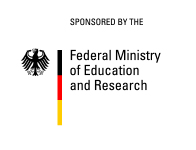BMBF
OmicsGlioma
OmicsGlioma investigates and develops diagnostic platforms and predictive algorithms for personalized medicine in recurrent glioblastomas.

OMICSGLIOMA
Omics-based integral approach for prediction of therapeutic success in treatment of human glioblastoma
This project is supported by the German Federal Ministry of Education and Research (BMBF) and administered by Projektträger Julich (PTJ) under Work programme EUROTRANS-BIO (Call ETB-10), grant 031B0145B
Summary of the project:
Glioblastoma multiforme (GBM) is one of the most aggressive types of cancer causing >120.000 human deaths annually. Globally, over 0.3 billion $ is spent annually for treatment of GBM. Recent developments in Next Generation Sequencing (NGS) technologies opened a new era in biomedicine by enabling fast and cost-effective high throughput analysis of gene expression linked with identification of mutations. Many original data that dealt with gene expression in GBM were published and deposited in the databases. Unfortunately, the data obtained using different experimental systems and even those using the same system are typically poorly comparable with each other, even for the same biosamples. In 2014, the consortium partner Biogerontology and Regenerative Medicine Center in Moscow introduced a bioinformatic tool termed OncoFinder for the analysis of activation of intracellular signaling pathways. They showed that OncoFinder-processed data correlate better for different NGS systems than raw gene expression levels, by showing ~0.8 correlation instead of ~0.1 for the raw data, and by effectively suppressing background effect otherwise clearly seen for gene expression measurements. They found 59 signaling pathway activation (SPA) values that may serve as efficient biomarkers of GBM. In this project, we plan to analyze >100 primary clinical glioblastoma samples and all available data from the public databases. We want to combine the advantages of NGS and OncoFinder technologies for the first time to create a unique diagnostic system predicting the efficiency of different therapeutics for glioblastoma treatment in an individual patient. The system will also screen for mutations affecting sensitivity to drug treatment, and provide a user-friendly interface for clinicians and for patients.
Consortium members: The Biogerontology and Regenerative Medicine Center, Moscow, Russia; Laboratory for Translational Neurooncology and Neurosurgery, University Medical Center, Mainz, Germany; StarSEQ GmbH, Mainz, Germany
Publications:
- Algorithmically Deduced FREM2 Molecular Pathway Is a Potent Grade and Survival Biomarker of Human Gliomas
- Intratumoral Heterogeneity and Longitudinal Changes in Gene Expression Predict Differential Drug Sensitivity in Newly Diagnosed and Recurrent Glioblastoma
- RNA-sequencing and bioinformatic analysis to pre-assess sensitivity to targeted therapeutics in recurrent glioblastoma
- Download the consortium poster from the Personalized Medicine Convention 2016 in Cologne
- Perspectives and Challenges in Molecular-Based Diagnostics and Personalized Treatment for Recurrent High-Grade Gliomas